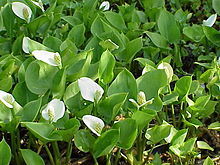- Calla
-
Calla palustris 
Scientific classification Kingdom: Plantae (unranked): Angiosperms (unranked): Monocots Order: Alismatales Family: Araceae Subfamily: Calloideae Genus: Calla Species: C. palustris Binomial name Calla palustris
L.Calla (Bog Arum, Marsh Calla) is a genus of flowering plant in the family Araceae, containing the single species Calla palustris. It is native to cool temperate regions of the Northern Hemisphere, in central, eastern and northern Europe (France and Norway eastward), northern Asia and northern North America (Alaska, Canada, northeastern contiguous United States).
It is a rhizomatous herbaceous perennial plant growing in bogs and ponds. The leaves are rounded to heart-shaped, 6–12 cm long on a 10–20 cm petiole, and 4–12 cm broad. The greenish-yellow inflorescence is produced on a spadix about 4–6 cm long, enclosed in a white spathe. The fruit is a cluster of red berries, each berry containing several seeds.
The plant is very poisonous when fresh due to its high oxalic acid content, but the rhizome, like that of Caladium, Colocasia and Arum, is edible after drying, grinding, leaching and boiling.[1]
The genus formerly also included a number of other species, which have now been transferred to the separate genus Zantedeschia. These plants, from tropical Africa, are however still often termed "calla lilies", but should not be confused with C. palustris.
References
- Blanchan, Neltje (2002). Wild Flowers: An Aid to Knowledge of our Wild Flowers and their Insect Visitors. Project Gutenberg Literary Archive Foundation.
- ^ A Dictionary of Flowering Plants and Ferns - JC Willis
External links

This Araceae-related article is a stub. You can help Wikipedia by expanding it.

